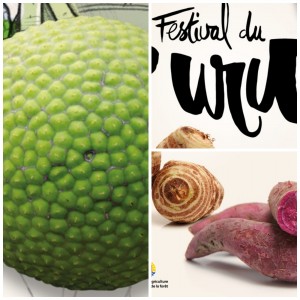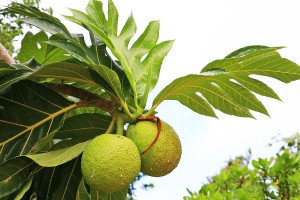 Featured at the Paris agricultural trade show at the Porte de Versaille, the Uru took center stage as the star amongst all the booths of the overseas French Territories! Small wonder for a fruit that Polynesians have always considered sacred. From March 17 to 19, Tahiti celebrates their love of the Uru with a festival solely devoted to this mythical fruit! The fruit of the breadfruit tree is an essential part of the Polynesia diet and culture.
Featured at the Paris agricultural trade show at the Porte de Versaille, the Uru took center stage as the star amongst all the booths of the overseas French Territories! Small wonder for a fruit that Polynesians have always considered sacred. From March 17 to 19, Tahiti celebrates their love of the Uru with a festival solely devoted to this mythical fruit! The fruit of the breadfruit tree is an essential part of the Polynesia diet and culture.
In the alleys of the Papeete market, you can buy an uru (pronounced URU) uru maoa, a ripe one, ready to be eaten. If you are unsuccessful, however, not to worry, the uru can be found easily throughout Polynesia and is easier hand-picked off a tree than purchased at the local market. Just look up in the trees when you take a walk in Tahiti or in the islands, you can’t miss them since you come across an uru tree every few yards … Handpicking them, however, takes a certain degree of agility: since breadfruit trees can measure up to at least 40 feet high. The locals therefore use a rou’uru, or a long pole to pick it off…an essential to every picking!
The potato of the tropics
The cradle of the uru is here in Polynesia! But it ventured beyond the borders of the Fenua during the late eighteenth century, when the William Bligh, captain of the famous “Bounty” transported large quantities in its hold to feed the West Indian slaves. Incidentally, the uru is also found in Caribbean cuisine, better known as the fouyapen in Martinican Creole.
Rich in carbohydrates, the uru is widely consumed in Polynesia today, especially as an accompaniment of the famous Ma’a Tahiti, the traditional Polynesian meal, shared on weekends or feasts days.
 Uru, 100 varieties and 1001 versions!
Uru, 100 varieties and 1001 versions!
In French Polynesia, there are a hundred different varieties of breadfruit, with as many shapes and tastes. Nevertheless, they essentially are characterized by their usual round green shape, sometimes oval, and may be even veering to yellowish color once they get closer to maturity come the month of February.
Traditionally, the uru is eaten plain, without any seasoning. It is a staple that is supposed to replace “bread”, hence the name “breadfruit”. Cooking entails placing the fruit directly on a wood fire or a gas burner of a standard gas stove top. Turning the fruit regularly, until its thick skin blackens on each side till the meat is soft and tender. The fruit is therefore cooked inside out, ready to be husked, pitted and cut into pieces or made into mash. The meat has the consistency of a potato. It is creamy, slightly sweet … a real culinary treat! Cut raw, the uru can also be boiled and cooked like scalloped potato gratin and even as fries for a more tropical version!
More recently, innovations in the different forms of the use of the uru have made it quite celebrated. Several brands advertise it as a good alternative to wheat flour (the Uru is naturally gluten free!), While the Brasserie de Tahiti, manufacturer of the famous local beer Hinano, came out with a beer in 2015, Pia Uru, which part of the malt has been replaced by uru flour… the result is rather flavorful. An absolute must during your next cocktail by the lagoon!
Practical information
The uru festival held from March 17 to 19 at the Maison de la Culture in Papeete
Exhibition and products for sale, tastings and conferences